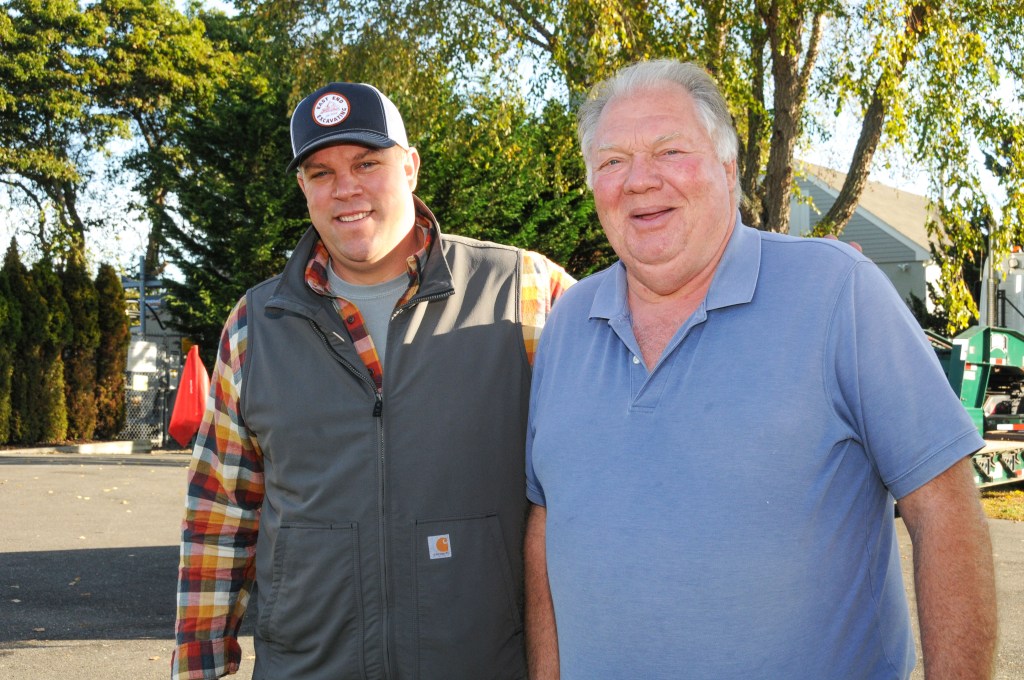Painting The Town Green

The Village of East Hampton Board of Trustees held a special meeting and work session on Thursday, September 6, to examine proposed legislation on issues such as septic system upgrade requirements, noise ordinances with regard to leaf blowers, and the drainage of Town Pond.
Consulting engineer Drew Bennett addressed the board and outlined the two-phase plan proposed to clean Town Pond. The plan is in response to the results of a water quality study that was conducted in 2016. The proposal calls for the removal of approximately 10,000 cubic yards of sediment and debris. The pilot phase would remove 1000 cubic yards of material from the southern end of the pond, by the stop light, and would serve as a trial to ensure that the removal process does not encounter any significant or unexpected problems. If successful, the balance of the project will be completed.
“If we encounter any problems, we would basically go back to the drawing board and come up with a different plan,” Bennett explained. “It’s obviously difficult material to handle and it’s a messy situation, so we said let’s start small and make sure the process works.”
Bennett said two methods are being considered. The first method would be to drain the pond by removing the boards at the outlet at the south end of the pond and letting the pond dry out. This would expose the sediment and enable its removal. The alternative would be the hydraulic suction and pumping of the water into a de-watering area that could be set up and surrounded by hay bales and the sediment could then be pumped into “geo bags.”
The board is seeking proposals from the contracting community. “Each contractor has their own equipment and experience, and their own workforce. Rather than dictating the process, we’ve given them a set of parameters that they could work in, areas that they can use to stockpile the material, and access to areas to do so,” said Bennett. The contractors’ proposals must include their intended use of the material they will be removing — recycling for use or disposal. In either situation, New York State Department of Environmental Conservation approval is required.
With the bidding and permitting process yet to begin, the project is not likely to have a start date until next year.
Defining Septic Triggers
Village Administrator Rebecca Hansen opened the discussion on septic system upgrades in the village.
Village Planner William Hajek advised the board that there are five innovative/alternative septic systems. Two reduce nitrogen output by 80 percent and the others by 50 percent. East Hampton Village Mayor Paul Rickenbach wanted assurance that the systems moved “in concert with the Suffolk County Department of Health services before recommending an I/A septic system,” especially since they are presently only “provisionally approved” by the county department.
Several members of the board, including the mayor, wanted to define the triggers requiring the installation of an upgraded system. The mayor requested that an exemption be made for those with septic system failures that require emergency repair. He said in these dire circumstances, it is not to require a homeowner to upgrade their system under these conditions. As each I/A project has to be individually designed, and the application to the County Health Department takes approximately eight weeks, Hajek agreed that emergency repairs may need to be handled differently.
Discussions also centered on how to define failing systems, repair verses replace, and the financial hardship that some homeowners may face with the new code. According to Hajek, Suffolk County has an income-based grant program, and low interest loans are available to homeowners who do not qualify for a grant. In addition, the town has a rebate program which includes the village, and is dependent upon location.
Currently, the Town of East Hampton’s code for septic system upgrades applies to both residential and commercial properties, stated Hajek, but other municipalities he researched only applied their upgrade code to residential properties. The board will consider legislation for I/A upgraded septic systems for new construction, or a 25 percent expansion of floor area for existing structures, or construction which increases the number of bedrooms, as well as include voluntary replacement of existing systems.
58 Leaf Blower Noise Complaints
The last item for discussion pertained to leaf blowers and the noise associated with them. Police Chief Michael Tracey reported that between June 1 to September 5 the precinct has received 58 noise related complaints, 21 of which were due to the use of landscaping equipment. Eleven of those were issued violations. The time of day, the day of the week, and whether the complaints were from a repeat caller, were not specified. Mayor Rickenbach stated, “It’s a quality of life issue.”
Recognizing that leaf blowers are essential tools for landscapers, the board discussed a “phase-in period.” Its hope is to minimize the financial burden to landscapers who will need to replace their equipment when legislation is drawn. With input from Bill Fox, owner of Bill Fox Grounds Maintenance, who indicated that the battery-powered leaf blowers will cost three times the cost of the gas-powered ones, the board said it will consider a three-year phase-in period.
Fox stated that he has already replaced three leaf blowers with battery-powered blowers and said that “it’s a lot nicer to change a battery rather than spilling the two-cycle gas mix.” He also indicated that Town of Southampton Councilwoman Christine Scalera is “trying to get rebates” for landscapers who purchase battery-powered equipment such as leaf blowers. Before closing the work session, the Mayor stated that the board will be inviting the public to discuss the matter further.
justin@indyeastend.com









